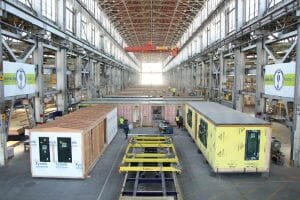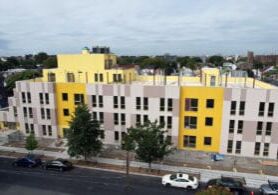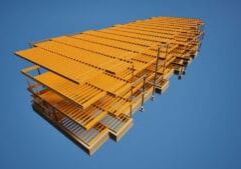Carpenter's Union Embraces Factory Built Housing to Address Labor Needs in Northern California
“We don’t have a labor shortage, we have an opportunity shortage,” said Jay Bradshaw, Director of Organizing for the Northern California Carpenters Regional Council (NCCRC). Not everyone agrees that the construction industry suffers from a labor shortage. NCCRC represents 37,500 members in 46 northern California counties and feels that labor availability is not the issue. “We have people who want to work, but with housing costs in the area, they are driving three hours to get here because they can’t afford to live in this region,” Bradshaw said.
Labor unions negotiate for higher wages and benefits for workers; higher wages, some argue, lead to higher construction and housing costs; which leads to fewer local available workers; which leads to higher housing costs. The cycle repeats continuously.
NCCRC has decided to address the issue head on – and in a manner not commonly employed by trade unions in the past. The carpenters group felt that it wasn’t in their members’ best interest to try to fight the move towards modular and offsite construction practices, as other trades have done in the past.
“We have a culture and a philosophy at the Carpenters of NorCal that when technology advances happen, we don’t try to fight it,” he says. “We want to be part of it, embrace it, support it, to stay viable in the industry, and to create more opportunities for our members. Not every organization takes that tactic”
But at the same time, the assembly line manner of construction tasks in a modular factory just didn’t neatly fit the traditional separation of trades, tasks, and wages that are common in organized labor agreements. Bradshaw continued, “Can you imagine if we built cars like this? Materials showing up in a driveway and multiple trades working on their specific part of the project. We’d end up with cars each costing about $800,000! We want to create good middle-class jobs while also trying to add to the inventory of affordable housing or everyone.”
So, NCCRC created what is called a “wall-to-wall contract” with modular factories. The idea is that the workers would be trained to do all aspects of the work, including electrical and plumbing, not just carpentry. And all the work in the factory would be covered by the carpenters’ union.
With a team of 35 full-time recruiters, NCCRC has been successful by targeting underserved populations in the construction industry such as women and minorities. But it’s not just the recruiting that makes this union successful. NCCRC trains its members at a facility near the two factories it currently represents, Factory OS and RAD Urban, each employing about 100 workers.
While the pay rate in the factory is lower than in the field, NCCRC still sees the benefit of this structure. “We’re elevating folks that don’t have opportunities and we’re going to help solve the housing crisis in Northern California,” says Bradshaw. He sees this new technology (modular) as a way to address the housing shortage by making it less costly to build. He says that when developers are able to build more, that means more construction work. Ultimately, that means more people can afford to live and work in the same area.
This article originally appeared in the Modular Advantage Magazine - Fourth Quarter 2018 released in November 2018.
More from Modular Advantage
Oregon’s Prevailing Wage Proposal: A Wake-Up Call for Modular Construction
In early February, 2024, the Massachusetts Board of Building Regulations and Standards (BBRS) released its proposed 10th Edition building codes. This draft included several amendments targeting modular construction that would have created an extremely difficult environment for the entire modular industry and could have eliminated the industry entirely in the state.
Behind the Design of Bethany Senior Terraces, NYC’s First Modular Passive House Senior Housing Project
As more developers seek to meet new regulations for energy efficiency, the team at Murray Engineering has set a new record. With the Bethany Senior Terraces project, Murray Engineering has helped to develop NYC’s first modular structure that fully encompasses passive house principles — introducing a new era of energy efficiency in the energy-conscious city that never sleeps.
How LAMOD is Using Modular to Address Inefficiency, Sustainability, and the Future of Construction
As developers, designers, and contractors seek to understand the evolving needs of the modular industry, no one is as well-versed in the benefits of going modular as Mārcis Kreičmanis. As the co-founder and CBDO of LAMOD in Riga, Latvia, Mārcis has made it his ultimate goal to address the inefficiencies of traditional construction.
From Furniture Builder to ‘Activist Architect’: Stuart Emmons’ Unique Journey
Stuart Emmons was fascinated by buildings at a young age. He remembers building sand cities with his brother during trips to the Jersey shore. His father gave him his first drawing table at the age of ten. Today, he is an experienced architect who received his FAIA in June 2025. The road he took is unique, to say the least.
Forge Craft Architecture + Design: Codes, Contracts, and Intellectual Property
Founding Principal and Director of Modular Practice for Forge Craft Architecture + Design, Rommel Sulit, discusses the implications of codes, contracts, and intellectual property on
modular construction.
Eisa Lee, the “Bilingual” Architect
Now as the founder of XL
Architecture and Modular Design in Ontario, Canada, she applies not just her education as a traditional architect but an entire holistic view on modular design. It’s this expansive view that guides her work on being a true partner that bridges the gap between architects and modular factories as they collaborate on the design process.
Tamarack Grove Engineering: Designing for the Modular Sector
The role of a structural engineer is crucial to the success of a modular project, from initial analysis to construction administration. Tamarack Grove offers structural engineering services — project analysis, plan creation, design creation, and construction administration — for commercial, manufacturing, facilities, public services, and modular. Modular is only one market sector the company serves but it is an increasingly popular one.
Engineer Masters the Art of Listening to His Customers
Since founding Modular Structural Consultants, LLC. in 2014, Yurianto has established a steady following of modular and container-based construction clients, primarily manufacturers. His services often include providing engineering calculations, reviewing drawings, and engineering certification
Inside College Road: Engineering the Modules of One of the World’s Tallest Modular Buildings
College Road is a groundbreaking modular residential development in East Croydon, South London by offsite developer and contractor, Tide, its modular company Vision Volumetric (VV), and engineered by MJH Structural Engineers.
Design for Flow: The Overlooked Power of DfMA in Modular Construction
Unlocking higher throughput, lower costs, and fewer redesigns by aligning Lean production flow with design for manufacturing and assembly.










